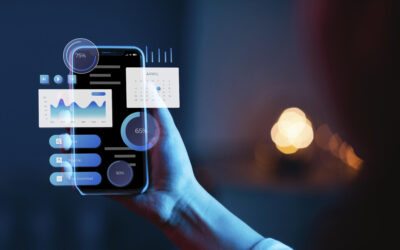Imagine controlling apps with just your voice or a wave of your hand—welcome to the screenless future!
Just ten years ago, designing a website required special tools and coding knowledge in languages like HTML and CSS. But now, things have changed. With platforms like WordPress and Figma, anyone familiar with these tools can create a website on their own.
As per the MuseMind Agency, In today’s digital landscape, the internet hosts over 1.2 billion websites, yet only about 17% are actively maintained and updated. This saturation underscores the critical need for exceptional user experiences to stand out.
What exciting developments and breakthroughs await us? How will these advancements reshape the way we interact with technology? In this article, we will look into the types of interactions in the screenless UI/UX.
Types of Interactions in Screenless UI
Andy Goodman, who invented the term, said: “humans have always had to interact with machines in a really abstract, complex way.” Screenless UI allows designers to facilitate users with next-level interaction experience using different types of user interfaces such as voice recognition and control, haptic feedback, ambient, gesture-based interaction, and context awareness. Utilizing any of these aspect organizations can deliver more realistic and human experience to the users.
Voice Recognition and Control
It’s a process where software or device identifies human voice and instruction, and according performs a particular action. When a user asks a question or gives a statement to the software, and the tool recognizes user’s query and reacts to it relatively. To provide proper respond on user’s command, the system has to be smart enough to understand user’s words, phrases, and syllables.
Designing of a conversation UI needs thorough user research to detect how users construct their statements or commands. A major challenge of voice recognition and control system is to adapt regional slang and dialect. The Screenless UI-based system can recognize the expression and phrasing of users by understanding their intents, motivations, and wants. The best examples of voice recognition and control are Siri and Amazon Echo.
Haptic Feedback
Haptic Feedback facilitates users with vibration-based feedback. It becomes a buzzword with the Apple Watch, as the user feels vibration on their hand when a message comes in. We have experienced the haptic while interacting with small screens. It is an important part of wearable products such as fitness trackers and smartwatches as they enable users with notifications.
In the near future, it will be available with smart clothing. Avoid overuse of haptic to enhance the value of the feedback for users. Moreover, ultrahaptics and ultrasounds will improve the sense of touch to Kinect style gaming and virtual reality.
Ambient
Ambient devices create a bridge between digital and physical space. It works on the principle of glanceability where there is no need to open notifications and applications. Ambient device-based interactions are connected and offer browserless experience.
Here, the devices allow users to access only required details and information. Well, the life of these devices is not so long, as they are not able to adopt updated technologies and changing information needs of users. Best examples of ambient interaction are Chumby and Nabaztag Rabbit.
Future of Screenless
Screenless future is the ultra-modern version of artificial intelligence. Soon Google Assistant, Siri and Alexa will become the memories of the precious past of the tech world. Advent of Screenless UI has all set to build incredible devices or products like Google Home, Amazon Dot and Amazon Echo that enable users to experience more human-like interactions.
Upcoming time will introduce the breakthrough devices that contain the outstanding capabilities of extending voice tech, speech science, multi-tasking, ultrasound, etc. Moreover, Screenless UI helps in boosting the concept of smart home at the speed of sound by advancing the way you manage various home appliances and activities.
Conclusion
Ready to design intuitive voice and gesture apps? Contact with The Expert Community to shape the screenless future.
Partner with The Expert Community to create voice and gesture solutions that cut costs and boost customer engagement.
FAQ
1: What are voice and gesture interfaces?
Voice and gesture interfaces are types of human-computer interaction systems that allow users to control devices or applications using spoken commands (voice interfaces) or physical movements (gesture interfaces), without the need for traditional input like keyboards or touchscreens.
2: Why are voice and gesture interfaces important for the future of app design?
These interfaces offer hands-free, intuitive experiences that are ideal for environments where screen interaction is limited or impractical, such as while driving, cooking, or for people with disabilities. They are paving the way for more inclusive and seamless technology.
3: What are some real-world examples of apps using voice or gesture interfaces?
Popular examples include Amazon Alexa, Google Assistant, and Apple Siri for voice control, and Microsoft Kinect, Apple Vision Pro, or Leap Motion for gesture-based interactions. Many smart TVs, gaming consoles, and even healthcare devices now use these technologies.
4: What are the main challenges in designing apps without screens?
Key challenges include ensuring accurate voice recognition, managing context awareness, designing intuitive feedback systems, and making the interface accessible to users with different accents, tones, or physical abilities. Designers must also consider privacy and noise interference issues.
5: How can developers start designing for voice and gesture interfaces?
Developers can begin by using tools like Google Dialogflow, Amazon Alexa Skills Kit, Microsoft Azure Speech Services, or OpenAI’s Whisper for voice apps. For gestures, platforms like Unity with ARKit/ARCore, or Leap Motion SDK can be helpful. The focus should be on natural user flow, error handling, and multi-modal feedback (audio, haptics, etc.).







